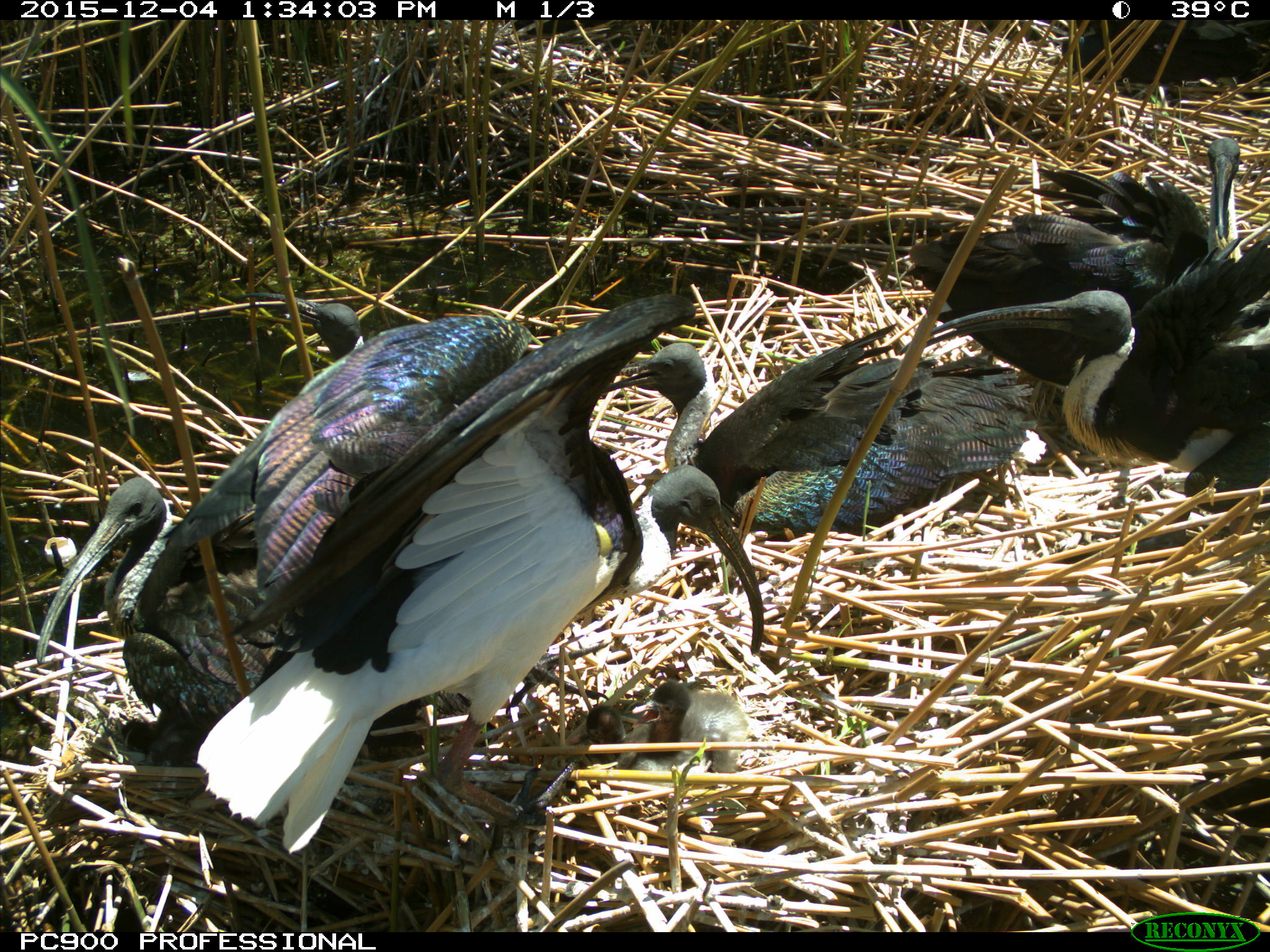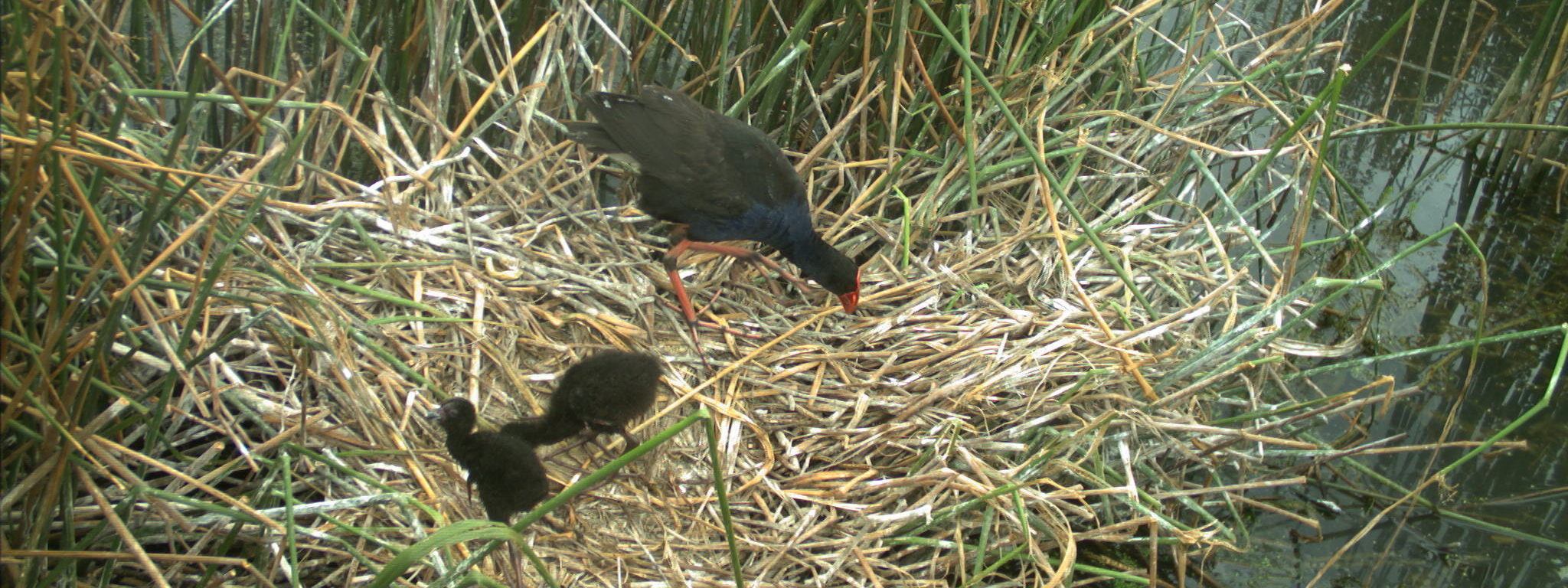Research Outcomes and Impact

How will our recruitment data from analysis of camera images be used? A straw-necked ibis shades their chicks from the sun. Image credit: CSIRO
Waterbird Research Project: how will our results be used?
The results from analysing aggregate-nesting waterbird breeding success and movements will inform recommendations for the planning, prioritisation and management of environmental water flows within the Murray-Darling Basin, with the objective of maximising waterbird recruitment. Specifically our research will inform water and natural resource managers of:
- The locations and characteristics of important foraging habitats
- The required location, extent and duration of water inundation in foraging and nesting habitats needed to maximise breeding success and recruitment
- How the characteristics of nesting habitats influence the number of chicks fledging, for example, how much nest position influences accessibility to predators
- Waterbird nesting habitat preferences and their implications for site management
- How water and vegetation management, and threats like predation, interact to affect waterbird recruitment
The research outcomes listed above will assist water and natural resource managers to:
- Better understand the scales at which key habitats and environmental flows are required to support waterbird recruitment.
- Better target environmental flows, vegetation and fauna management action
- Ensure ‘event readiness’ at nesting sites between flooding events
- Maximise recruitment during and after flooding events
- Identify, maintain or restore key nesting habitat characteristics
- Identify, maintain or restore key foraging habitats
- Link tracked movements of waterbirds and breeding success with foraging habitat characteristics at multiple scales
Our impact
Our waterbird research has had great success in terms of impact with clients, other stakeholders and the general public. In particular, the results of our research into waterbird movements and chick energy and food requirements have been taken up with enthusiasm. Our results and management recommendations have been explicitly incorporated into the Murray-Darling Basin Environmental Watering Strategy by the Murray-Darling Basin Authority (MDBA) and into planning undertaken by the Commonwealth Environmental Water Office (CEWO). They have also been taken into account in a range of other watering plans, watering actions and projects by the CEWO, the MDBA, the Victorian Environmental Water Holder (VEWH) and other State bodies including Victorian Catchment Management Authorities (CMAs) such as North-Central CMA.
A selection of some of the written feedback so far includes:
“Just a quick note to let you know how much I really enjoy and am learning a lot from the updates you are sending through (I work on both the Lachlan and Mid Murray regions in the CEWO). Your work is also informing the very early stages of our internal discussions/thinking re the need for e-water planning to be done/linked at the scale at which these flyways are operating. It is awesome work & greatly appreciated at this end.” – CEWO
“This is so exciting. I showed a few colleagues (just internal) and it is causing such a buzz of excitement, with one person commenting that this is the best thing they have seen in 4 and half years of working in the CEWO! Well done, there is going to be so much interest in this. Love the names, where was Gough Whitlam going? Are trackers on male or females? And does it track them going and coming back? Well done again, we are really excited here about the work you are doing.” – CEWO

“Just a quick email to say that I am enjoying the facebook links about your bird tracking. The little blighters certainly get about. I think this is a really important area of research – with environmental watering the assumption is that if we add water – everything will respond. I think what you are showing is the system is much more complex than that and that here are other cues that the ecosystem – water birds in your case – are responding to. Many of these other cues we don’t know –let alone measure. ……..(more comments)…. I think that your research will help people to understand the need to work in sync with nature”. – MDBA
“I reckon this is some of the most exciting work going! It really feeds into/informs our thinking about beyond catchment scale event management.” – NSW Office of Environment & Heritage

“This research is really fantastic and provides a much better picture of the needs waterbirds have in breeding and feeding areas in there migratory movements. Staging sites along these migratory paths are critical elements for waterbirds to move about the landscape and to take advantage of areas in varying climatic conditions. With the information gathered from this research, one of the priorities should be to provide information to farmers and landholders as well as water managers and decision-makers. If the landowners appreciate the story and needs of the birds they will be better equipped to look at better water use themselves. The other advantage of the research will be to verify the importance of environmental watering for both major and smaller wetland areas. One of the biggest problems in convincing managers of water allocation to look at the environmental needs has been the lack of information about the importance of adequate water being provided to wetlands to ensure that they remain healthy. This research should be published and spread around the Murray-Darling Basin as widely as possible to get the message out. In a related exercise, the Woodlands and Wetlands Trust in the ACT is doing a similar although smaller scale tracking project with Latham’s Snipe in their migratory paths between Australian and Japan. Results have shown the Snipe also depend on MDB wetlands where they stopover on their flights north and south. This is adding to the need to ensure that managers and users of water in the Basin have a more comprehensive understanding of environmental needs as well as production needs and the studies on waterbirds will go a long way to assist this.” – Woodlands & Wetlands Trust
“Thank you so much Heather. What a privilege to see this data.” – Independent consultant
“A few weeks back I was talking to (a director) at CEWO and he mentioned you specifically as doing a great job. Thought you’d like to know – top job. ” – Independent consultant
